Novel Electrothermal Microgrippers Based on a Rotary Actuator System
Abstract
:1. Introduction
| Ref. | Microgripper Type | Microactuator Type | Structural Material | Software for Simulation | Dimensions (µm) | Feed | Displacement of Tips (µm) | Initial Gap (µm) | Force on Tips (µN) | Stress (MPa) |
|---|---|---|---|---|---|---|---|---|---|---|
| [7] | Electrothermal | U-Beam | Silicon | Gmsh and MATLAB | NA | 397.5 °K | ≈2.6 | NA | NA | NA |
| [19] | Electrothermal | Hot arms | SU-8 and Cr/Au/Cr-based | ANSYSTM Solid 98 | ≈1000 × 140 × 20 | 180 °C at 650 mV | ≈50.5 and 47.8 | 30.5 and 30.1 | NA | NA |
| [20] | Compliant | External actuation | SU-8 | ANSYSTM | ≈1000 × 390 × 20 | NA | ≈35 | 10 | ≈25 | 32.94 |
| [21] | Electrostatic | Comb drive | NA | FEA | NA | 80 V | ≈30 | NA | ≈140 to 160 | NA |
| [22] | Electrothermal | U-Beam | Polysilicon | CoventorWareTM | ≈400 × 42 × 2 | 5 V | 15 | 5 | NA | NA |
| [23] | Electrothermal | Beams | SU-8 and Au | NA | ≈1300 × 610 × 10 | 0.65 V and 0.7 V | 11 and 8 | 40 | NA | NA |
2. Materials and Methods
2.1. Design Concept and Simulation
2.2. Modelling of Microactuators
2.2.1. Thermal Elongation of Beams
2.2.2. Electromechanical Modeling of Two Beams to a U-Beam-like Microactuator
2.2.3. Electromechanical Modeling of V-Shaped Beam Microactuator
2.3. Pseudo-Rigid Body Model of Microgripper Model 2
3. Results of Theoretical and Numerical Models and Discussion
- Validation of the 2-beam microactuator as a U-beam-like microactuator.
- Validation of the 4-beam microactuator as a U-beam-like microactuator.
- The V-shaped beam microactuator with 2 and 16 beams.
3.1. Thermal Beams Elongation
3.2. Electromechanical Modeling of Two Beams vs. U-Beam-like Microactuator
3.3. Electromechanical Modeling of Four-Beam Microactuator
3.4. Validation Electromechanical Modeling of V Beam Microactuator
3.5. Results by Element Finite Method of Microgrippers Models 1 and 2
3.6. Comparison with Other Microgrippers
4. Feasibility of Fabrication
5. Conclusions
Author Contributions
Funding
Data Availability Statement
Conflicts of Interest
References
- Kalaiarasi, A.R.; Deepa, T.; Angalaeswari, S.; Subbulekshmi, D.; Kathiravan, R. Design, simulation, and analysis of micro/nanoelectromechanical system rotary devices. J. Nanomater. 2021, 2021, 1–13. [Google Scholar] [CrossRef]
- Hussein, H.; Fariborzi, H.; Younis, M.I. Modeling of beam electrothermal actuators. J. Microelectromech. Syst. 2020, 29, 1570–1581. [Google Scholar] [CrossRef]
- Ling, M.; Cao, J.; Pehrson, N. Kinetostatic and dynamic analyses of planar compliant mechanisms via a two-port dynamic stiffness model. Precis. Eng. 2019, 57, 149–161. [Google Scholar] [CrossRef]
- Wang, R.; Zhang, X.; Yin, Z. Design and stiffness modeling of a compact 3-DOF compliant parallel Nanopositioner for the tool servo of the Ultra Precision Machining. In Proceedings of the 2018 IEEE International Conference on Robotics and Biomimetics (ROBIO), Kuala Lumpur, Malaysia, 12–15 December 2018. [Google Scholar]
- Zhang, Y.; Sun, J.; Liu, H.; Liu, Z. Modeling and measurement of thermal–mechanical-stress-creep effect for RF MEMS switch up to 200 °C. Micromachines 2022, 13, 166. [Google Scholar] [CrossRef]
- Yang, S.; Xu, Q. Design of a microelectromechanical systems microgripper with integrated electrothermal actuator and Force Sensor. Int. J. Adv. Robot. Syst. 2016, 13, 172988141666337. [Google Scholar] [CrossRef]
- Roy, A.; Nabi, M.; Rahman, N. Finite element compatible matrix interpolation for parametric model order reduction of electrothermal microgripper. J. Comput. Des. Eng. 2021, 8, 1622–1635. [Google Scholar] [CrossRef]
- Vinoy, K.J.; Ananthasuresh, G.K.; Pratap, R.; Krupanidhi, S.B. MEMS piezoresistive accelerometers. In Micro and Smart Devices and Systems; Springer India: New Delhi, India, 2014. [Google Scholar]
- Pourrostami, H.; Kargarnovin, M.H.; Zohoor, H. Modeling and analytical solution of Hybrid Thermopiezoelectric micro actuator and performance study under changing of different parameters. Mech. Adv. Mater. Struct. 2014, 22, 785–793. [Google Scholar] [CrossRef]
- Lin, S.C.; Lee, B.S.; Wu, W.J.; Lee, C.K. Multi-cantilever piezoelectric MEMS generator in energy harvesting. In Proceedings of the 2009 IEEE International Ultrasonics Symposium, Rome, Italy, 20–23 September 2009. [Google Scholar]
- Poliakine, J.; Civet, Y.; Perriard, Y. Modeling and characterization of a MEMS synchronous generator. In Proceedings of the 2014 17th International Conference on Electrical Machines and Systems (ICEMS), Hangzhou, China, 22–25 October 2014. [Google Scholar]
- Chappel, E. Chapter 3-Micropumps for drug delivery. In Drug Delivery Devices and Therapeutic Systems; Academic Press: New York, NY, USA, 2020. [Google Scholar]
- Botta, F.; Rossi, A.; Belfiore, N.P. A feasibility study of a novel piezo MEMS tweezer for soft materials characterization. Appl. Sci. 2019, 9, 2277. [Google Scholar] [CrossRef] [Green Version]
- Jain, A.; Qu, H.; Todd, S.; Xie, H. A thermal bimorph micromirror with large bi-directional and vertical actuation. Sens. Actuators A Phys. 2005, 122, 9–15. [Google Scholar] [CrossRef]
- Llewellyn-Evans, H.; Griffiths, C.A.; Fahmy, A. Fahmy Microgripper design and evaluation for automated l-wire assembly: A survey. Microsyst. Technol. 2020, 26, 1745–1768. [Google Scholar] [CrossRef]
- Steiner, H.; Hortschitz, W.; Stifter, M.; Keplinger, F.; Sauter, T. Thermal actuators featuring large displacements for passive temperature sensing. Microsyst. Technol. 2013, 20, 551–557. [Google Scholar] [CrossRef]
- Alogla, A.; Amalou, F.; Scanlan, P.; Shu, W.; Reuben, R.L. Development of a pneumatically actuated cantilever based Micro-tweezer. Procedia Eng. 2014, 87, 1390–1393. [Google Scholar] [CrossRef] [Green Version]
- Vargas-Chable, P.; Ferrara-Bello, C.A.; Sandoval-Reyes, J.O.; Tecpoyotl-Torres, M.; Varona, J. A novel electrothermal compliance microgripper. In Proceedings of the 2019 International Conference on Mechatronics, Electronics and Automotive Engineering (ICMEAE), Cuernavaca, Mexico, 26–29 November 2019. [Google Scholar]
- Somà, A.; Iamoni, S.; Voicu, R.; Müller, R.; Al-Zandi, M.H.; Wang, C. Design and experimental testing of an electro-thermal microgripper for cell manipulation. Microsyst. Technol. 2017, 24, 1053–1060. [Google Scholar] [CrossRef]
- De Pasquale, G. Design and modeling of MEMS microgrippers for laser-based additive manufacturing. Micro 2022, 2, 225–239. [Google Scholar] [CrossRef]
- Phelan, M.; Furlong, C. Characterization of a MEMS electrostatic Microgripper for micromanipulation and sensing. Micro Nanomechanics 2017, 5, 65–72. [Google Scholar]
- Cauchi, M.; Mollicone, P.; Mallia, B.; Grech, I.; Portelli, B.; Sammut, N. Design and fabrication considerations, numerical modelling, and testing of a MEMS microgripper. In Proceedings of the 2018 Symposium on Design, Test, Integration & Packaging of MEMS and MOEMS (DTIP), Rome, Italy, 22–25 May 2018. [Google Scholar]
- Al-Zandi, M.H.; Wang, C.; Voicu, R.; Muller, R. Measurement and characterization of displacement and temperature of polymer based electrothermal microgrippers. Microsyst. Technol. 2017, 24, 379–387. [Google Scholar] [CrossRef]
- Farokhi, H.; Ghayesh, M.H.; Hussain, S. Large-amplitude dynamical behaviour of microcantilevers. Int. J. Eng. Sci. 2016, 106, 29–41. [Google Scholar] [CrossRef]
- Atre, A. Analysis of out-of-plane thermal microactuators. J. Micromechanics Microengineering 2005, 16, 205–213. [Google Scholar] [CrossRef]
- Kaajakari, V. Practical MEMS Analysis and Design of Microsystems, MEMS Sensors (Accelerometers, Pressure Sensors, Gyroscopes), Sensor Electronics, Actuators, RF MEMS, Optical MEMS, and MIRCROFLUIDIC Systems; Small Gear Publ.: Las Vegas, NV, USA, 2009. [Google Scholar]
- Huang, Q.-A.; Lee, N.K. Analytical Modeling and optimization for a laterally-driven polysilicon thermal actuator. Microsyst. Technol. 1999, 5, 133–137. [Google Scholar] [CrossRef]
- Hoang, K.T.; Nguyen, D.T.; Pham, P.H. Impact of design parameters on working stability of the electrothermal V-shaped actuator. Microsyst. Technol. 2019, 26, 1479–1487. [Google Scholar] [CrossRef]
- Shivhare, P.; Uma, G.; Umapathy, M. Design enhancement of a chevron electrothermally actuated microgripper for improved gripping performance. Microsyst. Technol. 2015, 22, 2623–2631. [Google Scholar] [CrossRef]
- Howell, L.L.; Midha, A. Parametric deflection approximations for end-loaded, large-deflection beams in compliant mechanisms. J. Mech. Des. 1995, 117, 156–165. [Google Scholar] [CrossRef]
- Kaajakari, V. Practical Mems; Small Gear Publ.: Las Vegas, NV, USA, 2009. [Google Scholar]
- Clear Polyethylene Microspheres 0.96 g/CC—1UM to 1700 um (1.7 mm). Available online: https://www.cospheric.com/CPMS_polymer_clear_microspheres_density096.htm (accessed on 1 December 2022).
- Soda Lime Solid Glass Microspheres 2.5 g/cc—Bulk with Coating Options—3 um to 75 um. Available online: https://www.cospheric.com/P2000_solid_soda_lime_glass_spheres_beads.htm (accessed on 1 December 2022).
- Poly(Methyl Methacrylate) PMMA Acrylic Microspheres and Spheres 1.2 g/CC—1 um to 3.5 mm. Available online: https://www.cospheric.com/polymer_large_pmma_acyrlic_microspheres.htm (accessed on 1 December 2022).
- Xiao, X.; Xi, R.; Li, Y.; Tang, Y.; Ding, B.; Ren, H.; Meng, M.Q.-H. Design and control of a novel electromagnetic actuated 3-dofs micropositioner. Microsyst. Technol. 2021, 27, 3763–3772. [Google Scholar] [CrossRef]
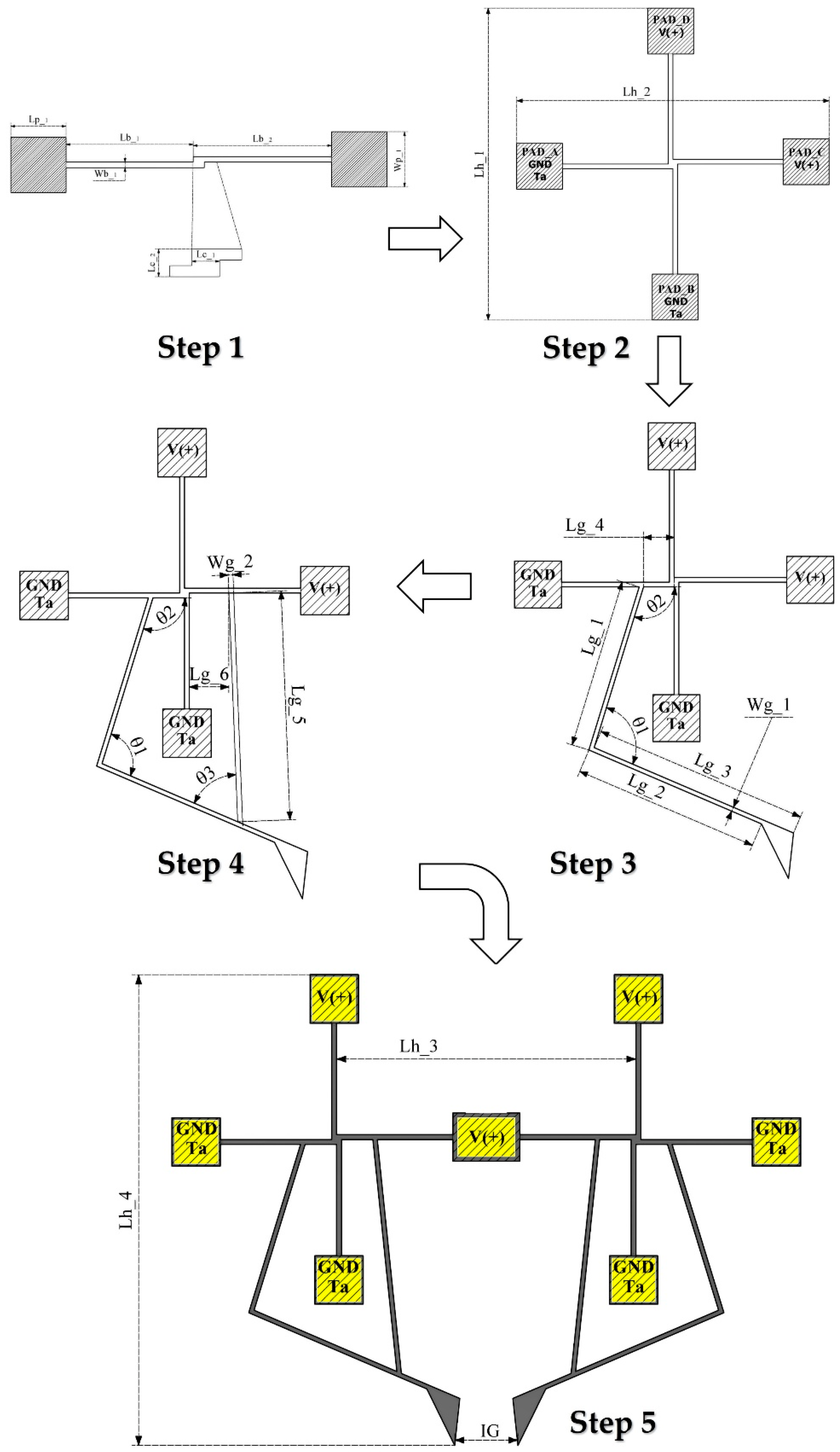
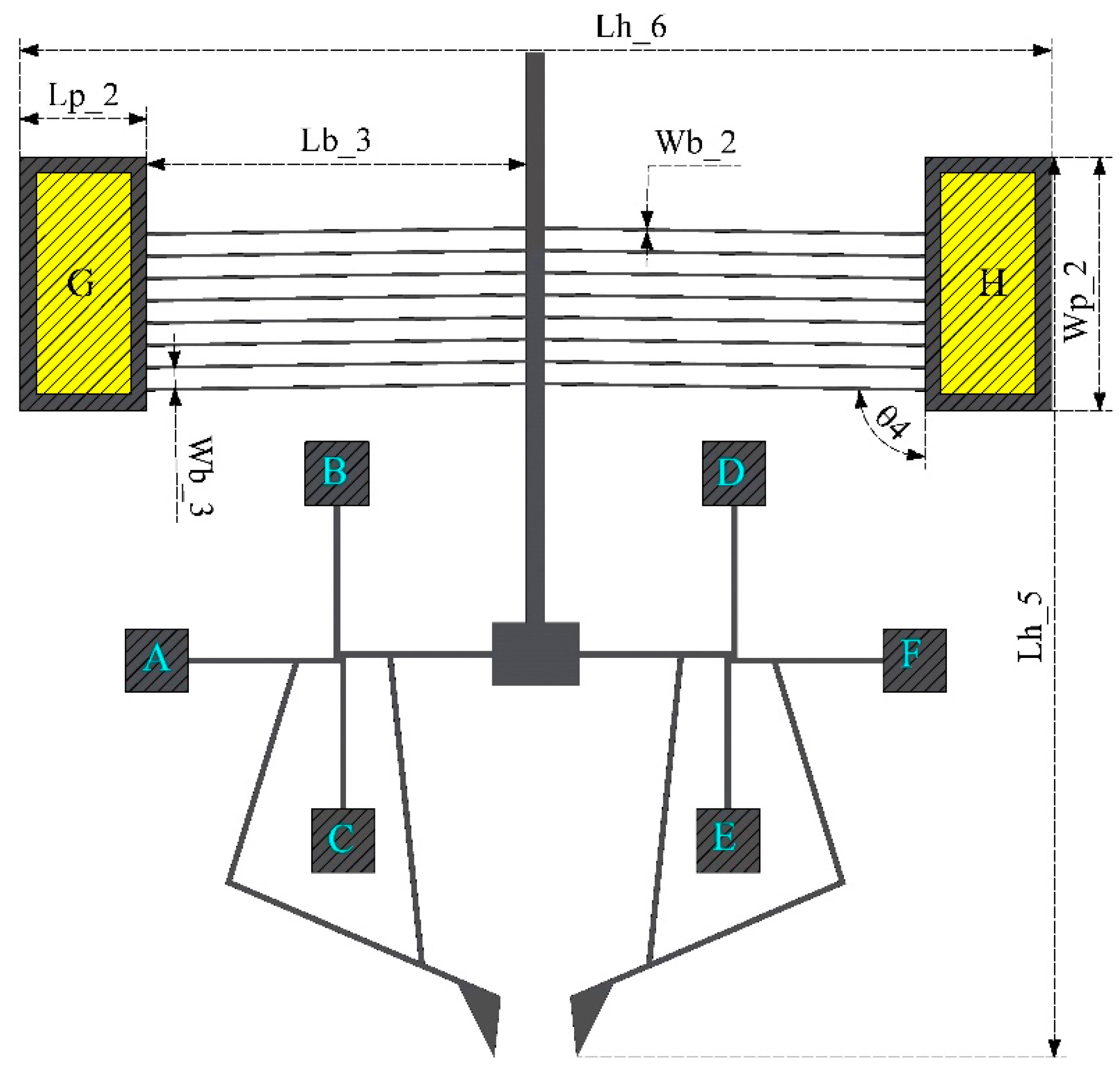
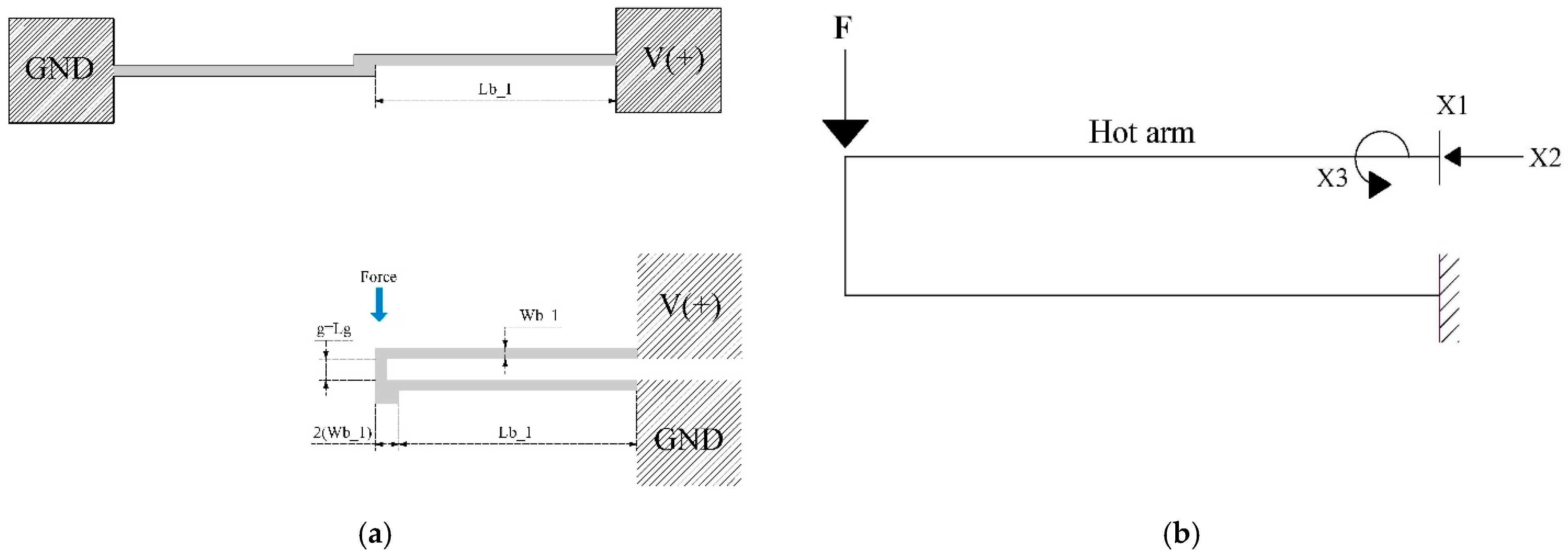
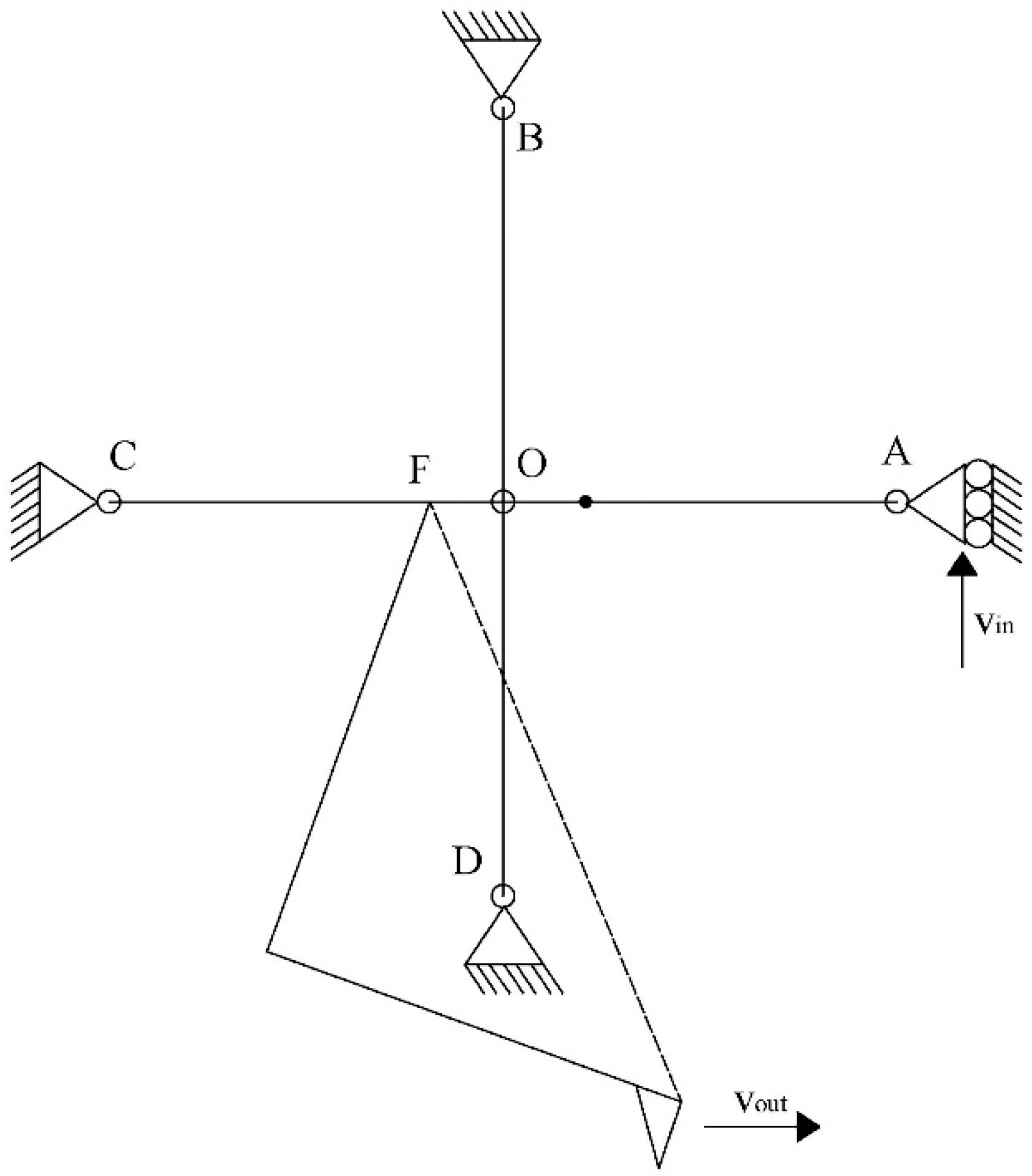
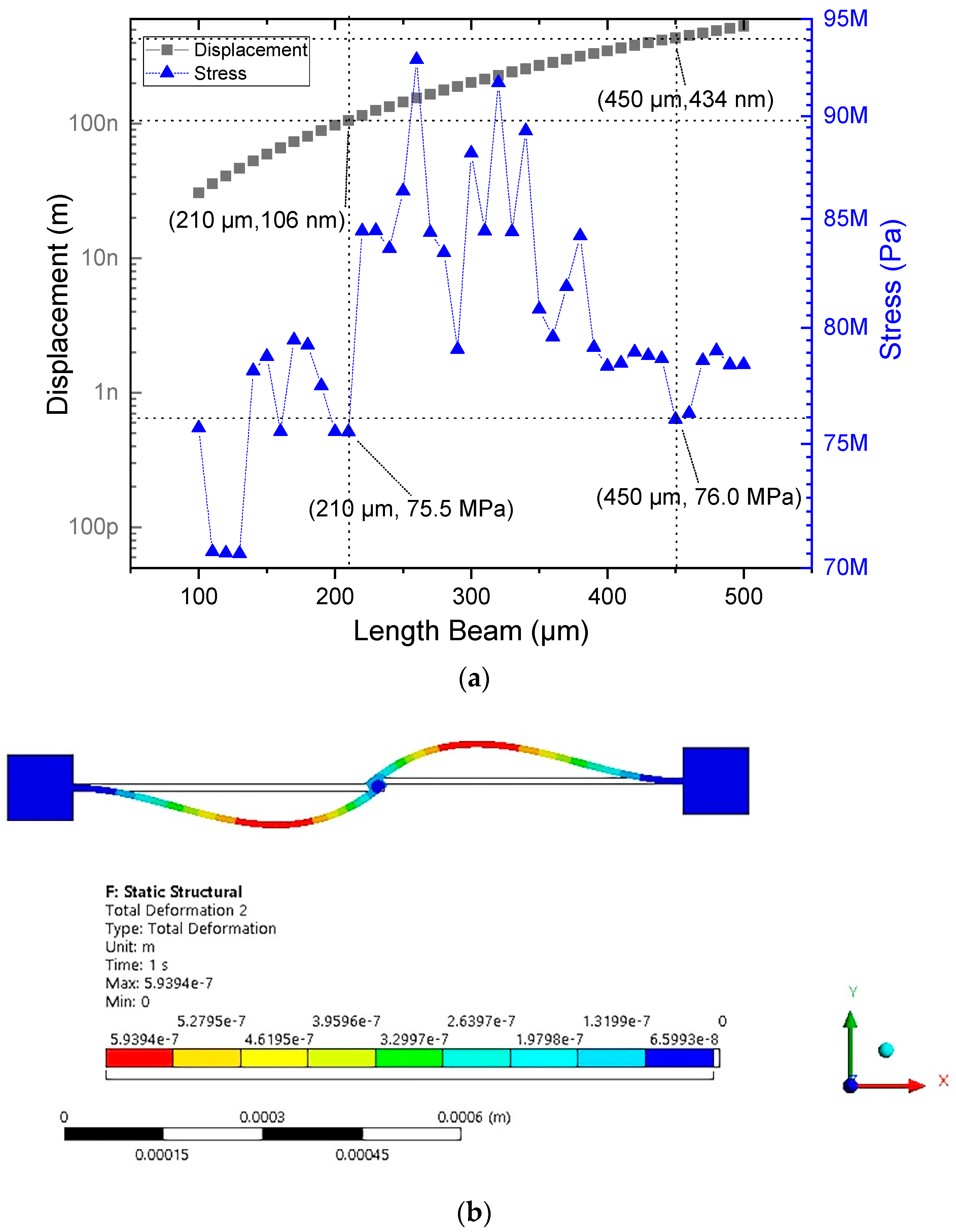
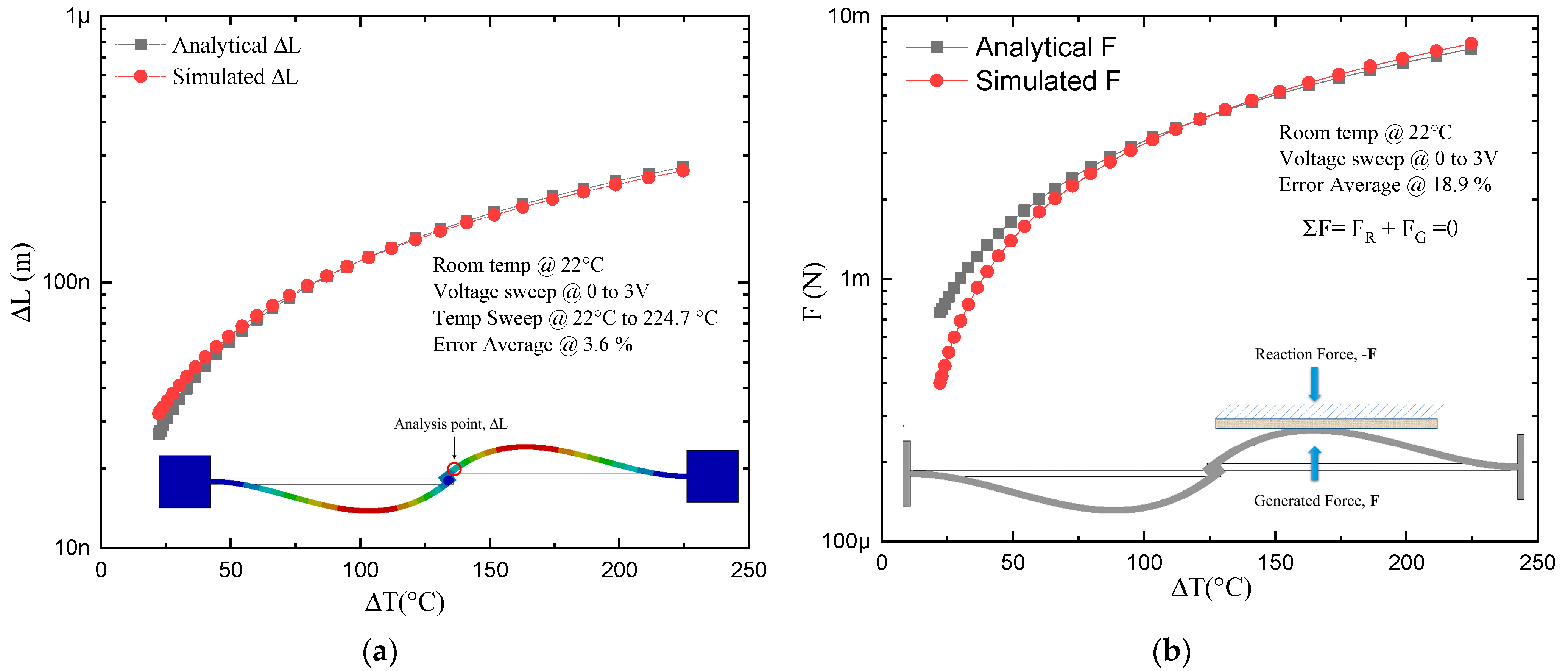
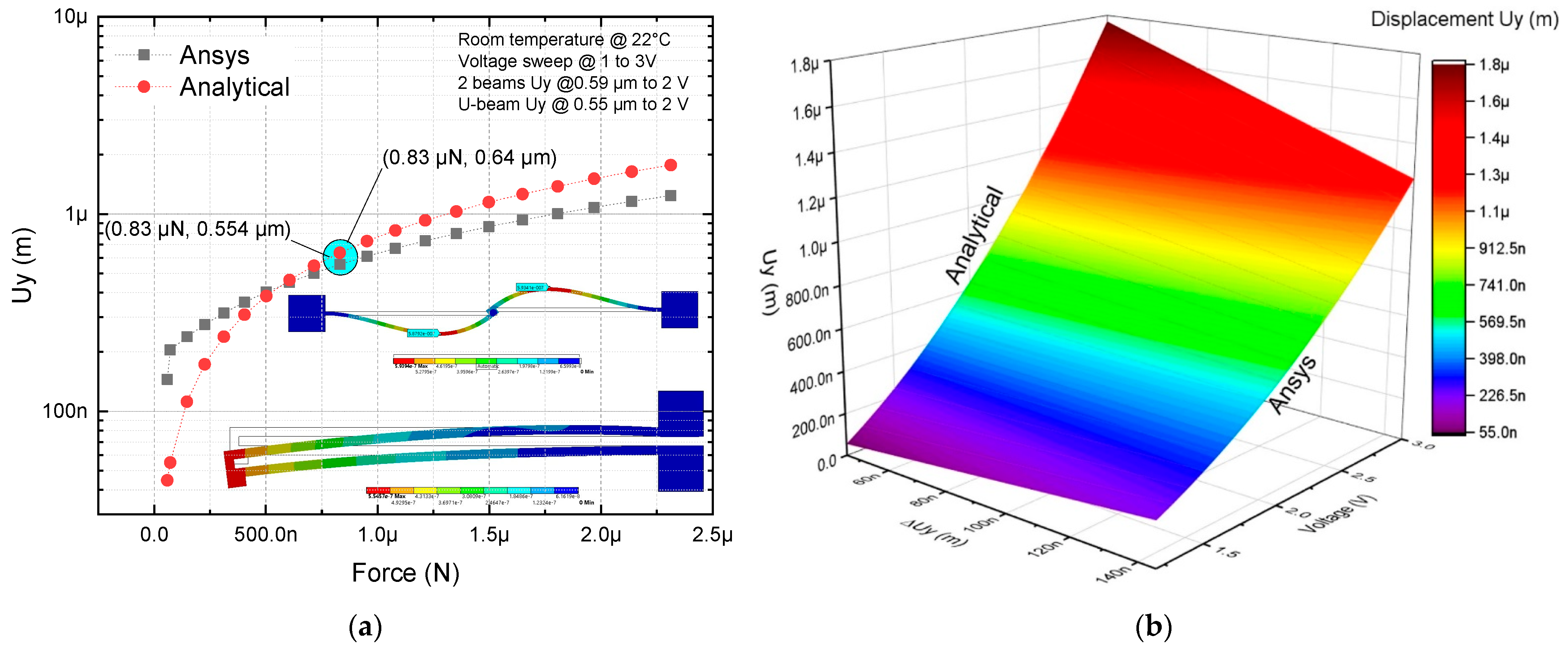
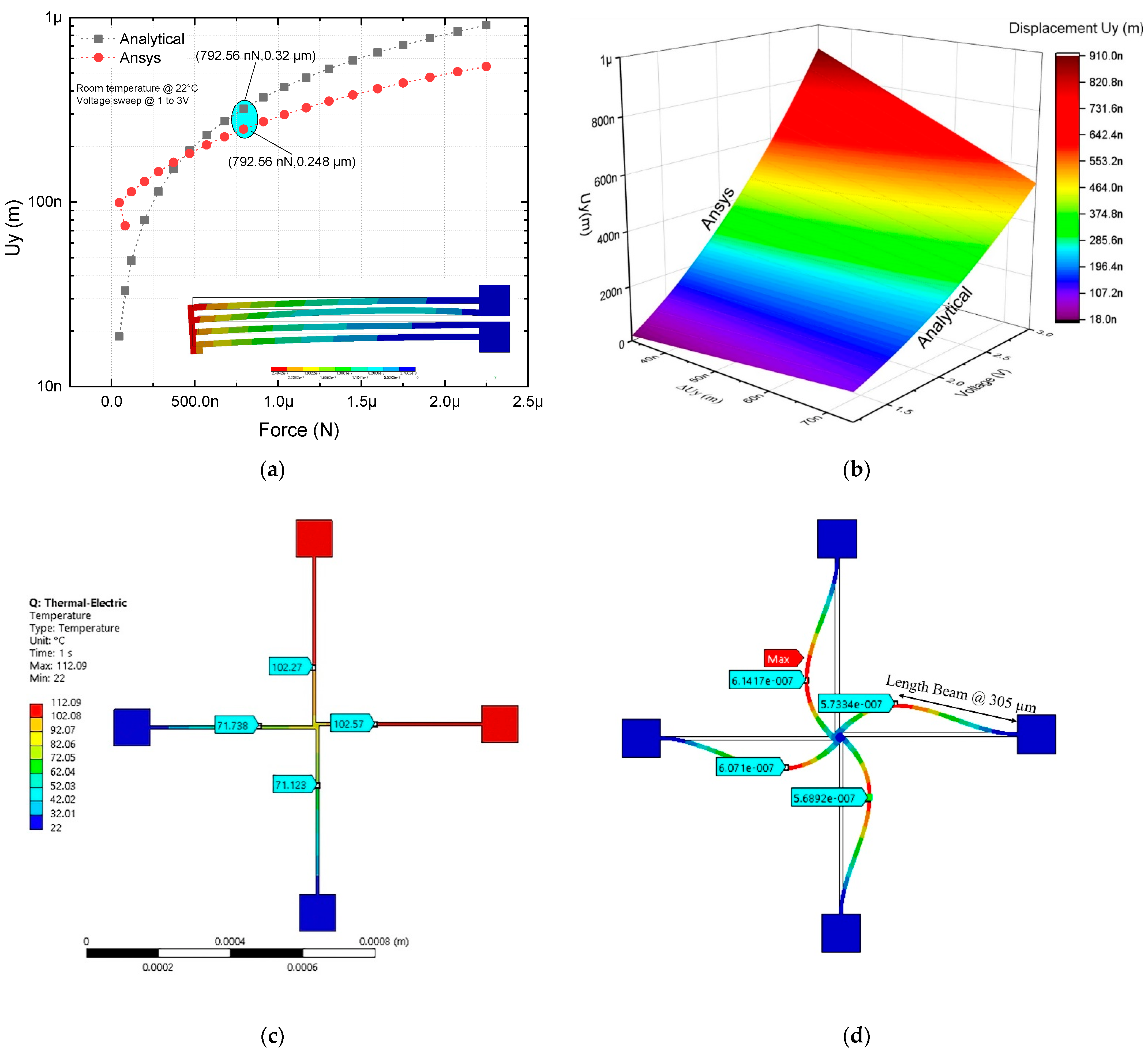

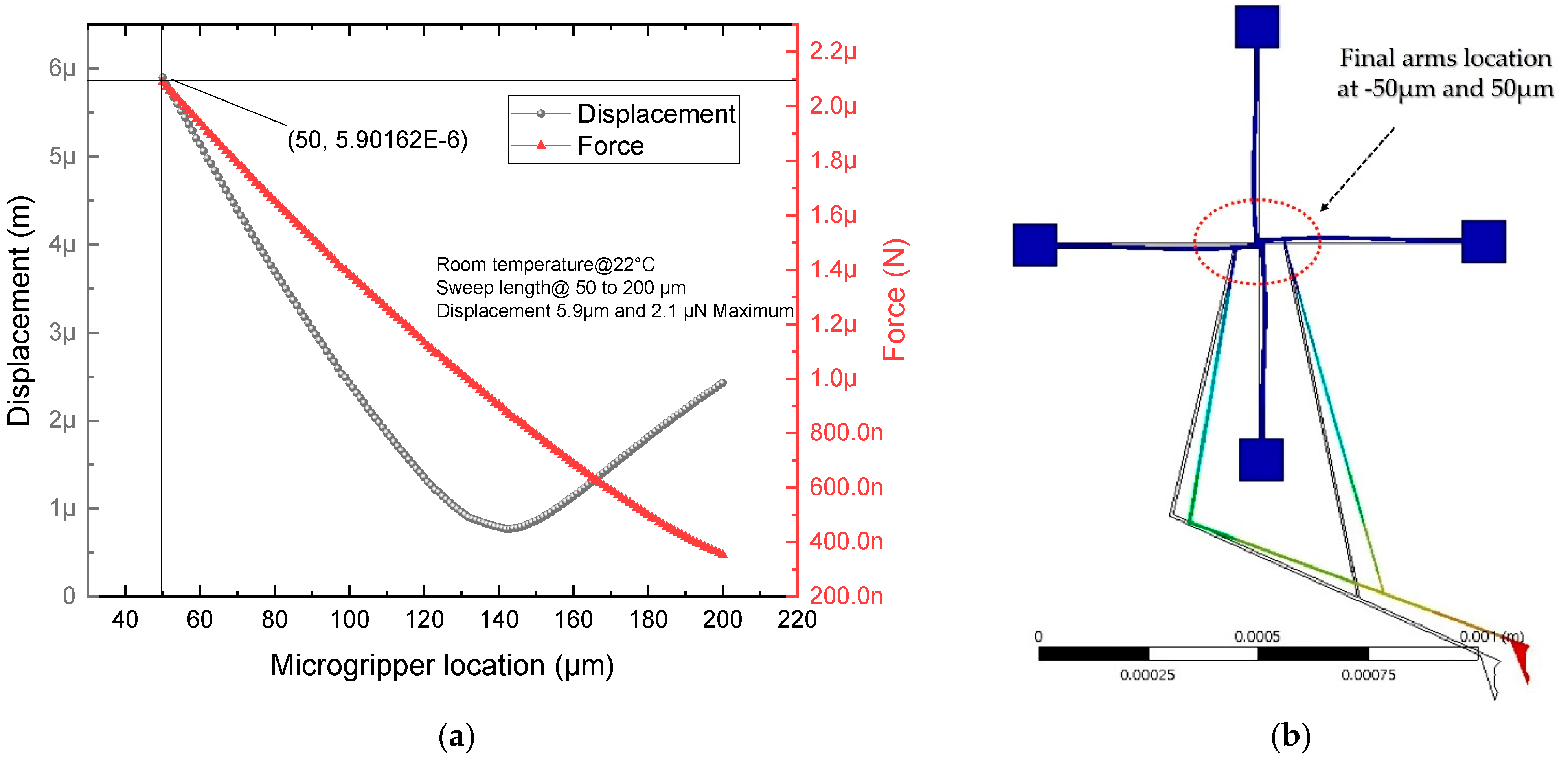
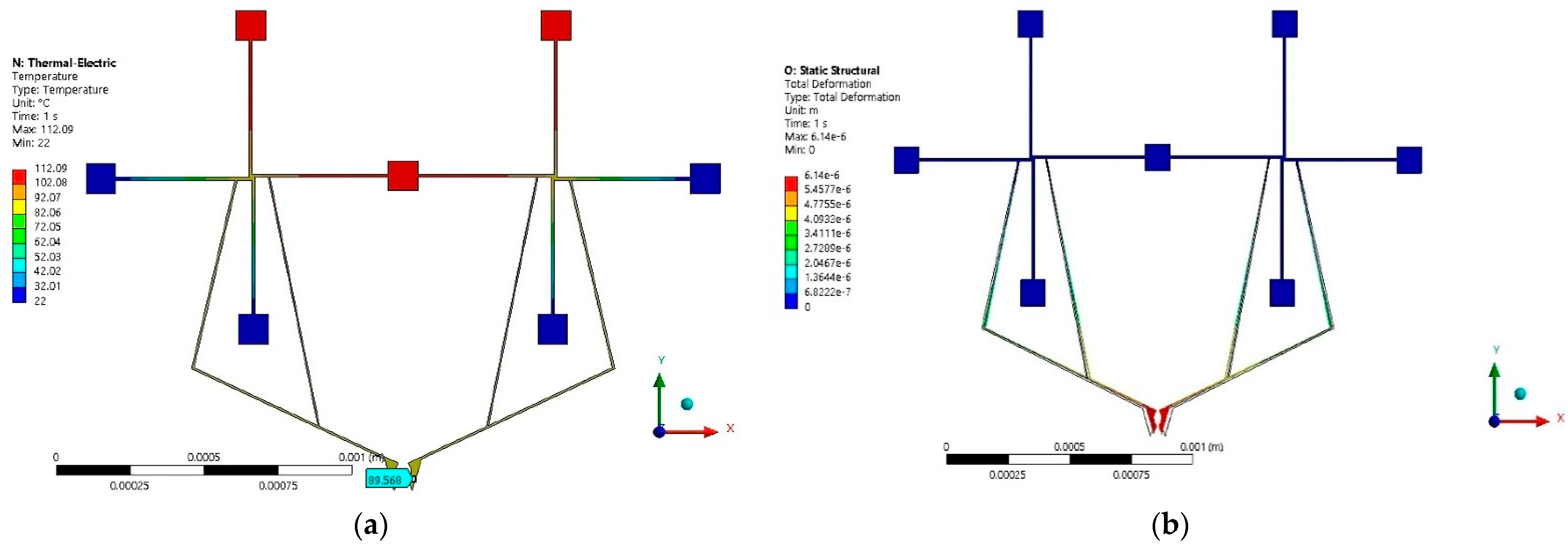
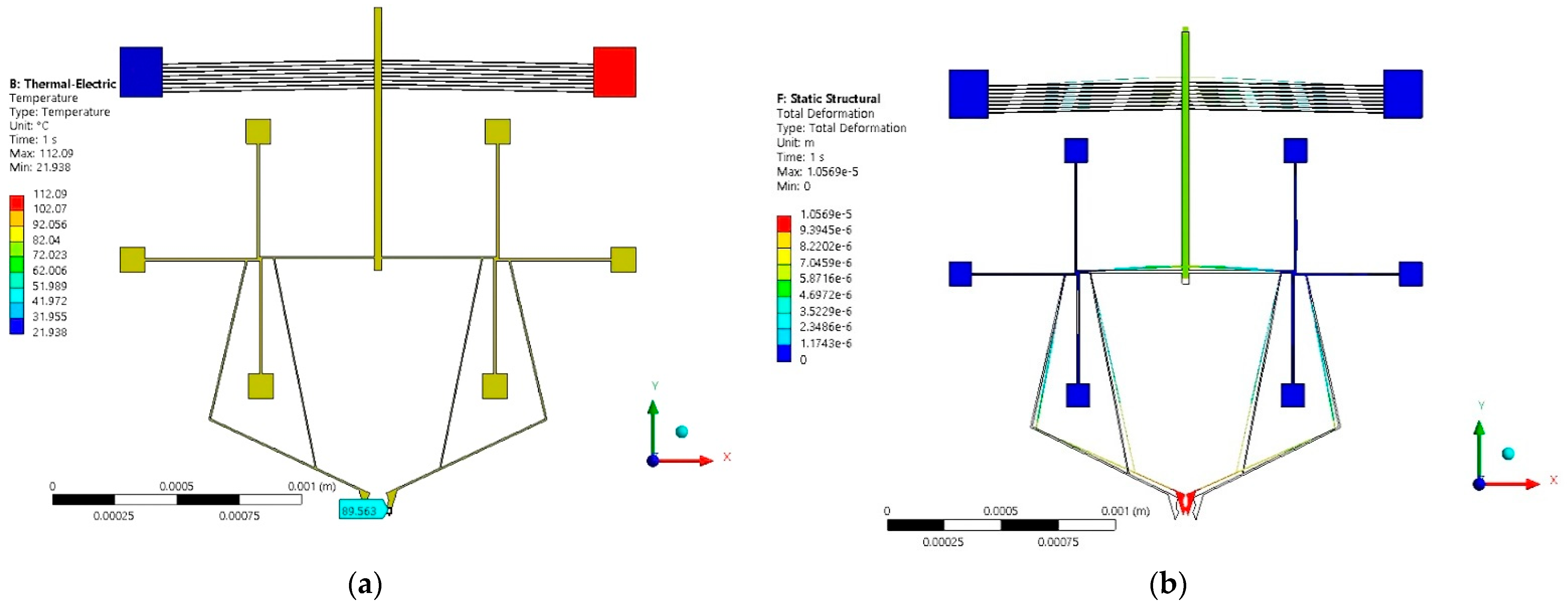
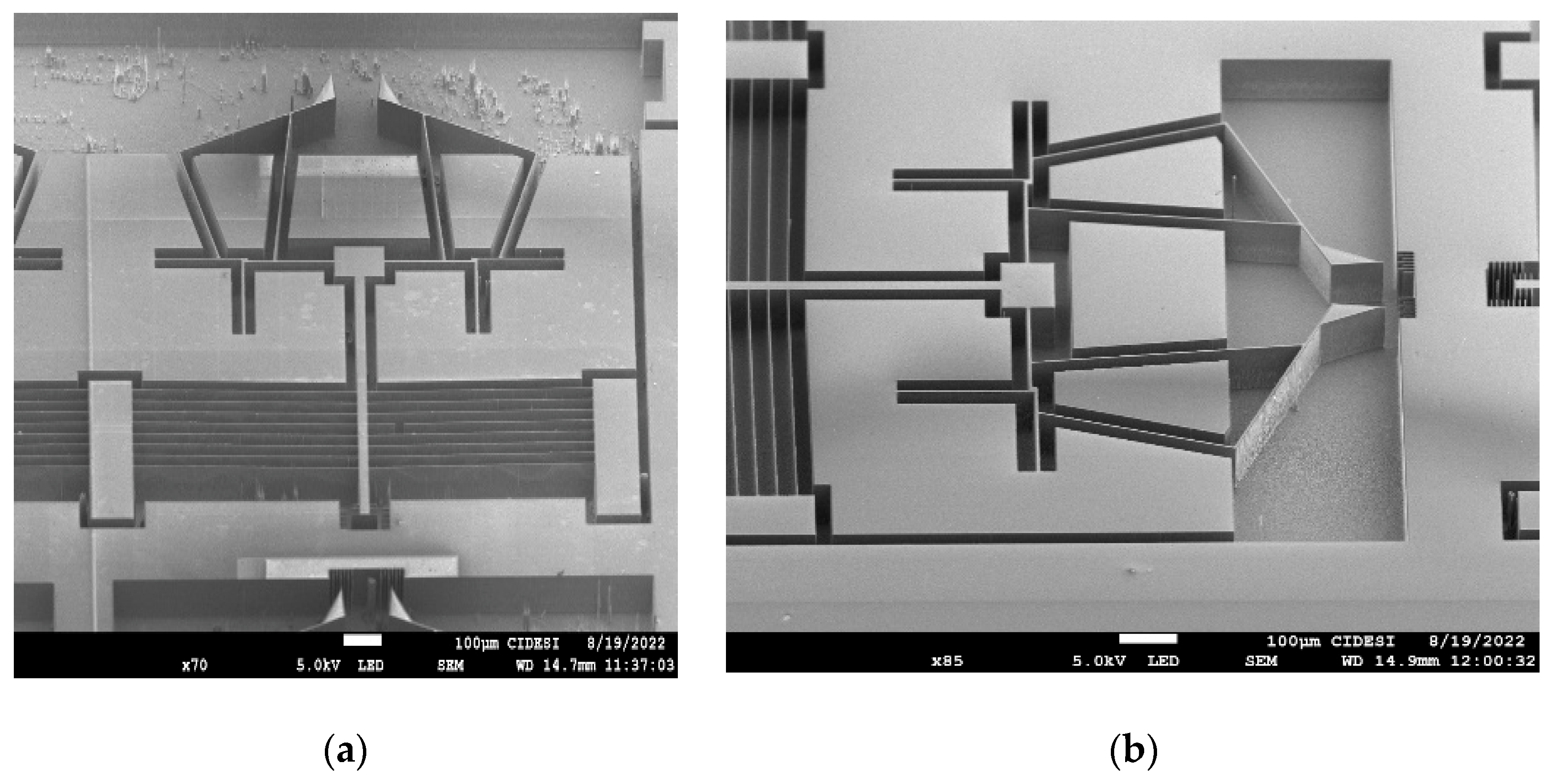
| Element Description | Size (µm) | Element Description | Size (µm) |
|---|---|---|---|
| Anchor length, MTB (Lp_1) | 100 | Length 6 of HMD (Lg_6) | 45 |
| Anchor width, MTB (Wp_1) | 100 | Width 1 of HMD (Wg_1) | 7 |
| Beam length 1, MTB (Lb_1) | 450 | Width 2 of HMD (Wg_2) | 5 |
| Beam length 2, MTB (Lb_2) | 470 | Length 1 of CM (Lh_3) | 1020 |
| Beam width 2, MTB (Wb_1) | 10 | Length 2 of CM (Lh_4) | 1611.5 |
| Total Length 1 of MFB (Lh_1) | 1120 | Initial gap (IG) | 54.53 |
| Total Length 2 of MFB (Lh_2) | 1120 | Total length microgripper (Lh_5) | 1873.2 |
| Length 1 of HMD (Lg_1) | 650 | Total width microgripper (Lh_6) | 2070 |
| Length 2 of HMD (Lg_2) | 664.21 | Anchor length of MVB (Lp_2) | 170 |
| Length 3 of HMD (Lg_3) | 704.21 | Anchor width of MVB (Wp_2) | 200 |
| Length 4 of HMD (Lg_4) | 50 | Beams width MVB (Wb_2) | 3 |
| Length 5 of HMD (Lg_5) | 853 | Distance between beams MVB (Wb_3) | 13 |
| Thickness (t) | 10 | Beam length MVB (Lb_3) | 850.13 |
| Length GF | 1049 | ||
| Element Description | Size (Degrees) | Element Description | Size (Degrees) |
| Angle 1 of HMD (θ1) | 101.9° | Angle 3 of HMD (θ3) | 126.3° |
| Angle 2 of HMD (θ2) | 103° | Angle 4 of MVB (θ4) | 1° |
| Parameters | Silicon Values |
|---|---|
| Density, 𝜌 (kg/m3) | 2329 |
| Thermal expansion coefficient, α (C−1) | 2.568 × 10−6 |
| Young’s modulus, E (GPa) | 130.1 |
| Poisson’s ratio, ν | 0.33 |
| Isotropic thermal conductivity, κ (W/m °C) | 148 |
| Isotropic resistivity, 𝜌0 (Ω × m) | 0.00015 |
| Room temperature, Ta (°C) | 22 |
| Average heat transfer coefficient, h (W/m2 K) | 25 |
| Convection coefficient (W/m2 °C) | 25 |
| Model Parameters | Temperature at 2 V | Analytical Results | Simulated Results | Error % |
|---|---|---|---|---|
| Displacement, ∆L (m) | 112.09 °C | 1.353 × 10−7 | 1.341 × 10−7 | 0.85 |
| Force, F (N) | 3.745 × 10−3 | 3.712 × 10−3 | 0.89 | |
| Stiffness, (N/m) | 27680.85 | 27669.36 | 0.041 |
| Device | Voltage (V) | Uy Ansys (µm) | Uy Analytical (µm) | |Error %| | F Ansys (µN) | F Analytical (µN) | |Error %| | Kc Ansys (N/m) | Kc Analytical (N/m) | |Error %| |
|---|---|---|---|---|---|---|---|---|---|---|
| U-beam-like microactuator with 2 beams | 1.5 | 0.315 | 0.239 | 31.8 | 0.312 | 0.399 | 21 | 0.99 | 1.67 | 68.5 |
| 1.6 | 0.358 | 0.309 | 15.7 | 0.404 | 0.516 | 21.7 | 1.13 | 1.67 | 47.74 | |
| 1.7 | 0.403 | 0.384 | 4.86 | 0.502 | 0.641 | 21.6 | 1.25 | 1.67 | 33.95 | |
| 1.8 | 0.451 | 0.463 | 2.69 | 0.606 | 0.773 | 21.6 | 1.34 | 1.67 | 24.20 | |
| 1.9 | 0.501 | 0.547 | 8.38 | 0.715 | 0.913 | 21.6 | 1.43 | 1.67 | 16.98 | |
| 2 | 0.555 | 0.636 | 12.8 | 0.830 | 1.06 | 17 | 1.50 | 1.67 | 11.43 | |
| U-beam-like microactuator with 4 beams | 1.5 | 0.146 | 0.114 | 21.91 | 0.282 | 0.380 | 25.7 | 1.93 | 3.34 | 42.21 |
| 1.6 | 0.164 | 0.151 | 7.92 | 0.373 | 0.504 | 25.9 | 2.27 | 3.34 | 32.03 | |
| 1.7 | 0.183 | 0.190 | 3.6 | 0.469 | 0.634 | 26 | 2.56 | 3.34 | 23.35 | |
| 1.8 | 0.204 | 0.231 | 11.6 | 0.571 | 0.771 | 25.9 | 2.79 | 3.34 | 16.46 | |
| 1.9 | 0.226 | 0.274 | 17.5 | 0.679 | 0.915 | 25.79 | 3 | 3.34 | 10.17 | |
| 2 | 0.248 | 0.320 | 22.5 | 0.793 | 1.06 | 25.18 | 3.19 | 3.34 | 4.49 |
| Device | Umax (µm) Ansys | Umax (µm) Analytical | Error (%) | Force Ansys (µN) | Force Analytical (µN) | Error (%) | kc Ansys (N/m) | kc Analytical (N/m) | Error (%) |
|---|---|---|---|---|---|---|---|---|---|
| Two beams V-shaped to 2 V with average temperature = 584.5 °C | 76.8 | 70.4 | 8.35 | 222.73 | 203.9 | 8.47 | 2.9 | 2.89 | 0.34 |
| Sixteen beams V-shaped to 2 V with average temperature = 588.7 °C | 74.1 | 70.9 | 4.33 | 1718 | 1643 | 4.40 | 23.18 | 23.16 | 0.086 |
| Device | Fx (N) | Fy (N) | Fz (N) | Total Force (N) | Ux (m) | Uy (m) | Uz (m) | U total (m) |
|---|---|---|---|---|---|---|---|---|
| Microgripper Model 1 | 3.76 × 10−10 | 8.96 × 10−6 | 7.36 × 10−11 | 8.96 × 10−6 | 5.65 × 10−6 | 2.5 × 10−6 | 5.63 × 10−9 | 6.14 × 10−6 |
| Device | Fx (N) | Fy (N) | Fz (N) | Total Force (N) | Ux (m) | Uy (m) | Uz (m) | U total (m) |
|---|---|---|---|---|---|---|---|---|
| Microgripper Model 2 | 1.52 × 10−8 | 3.42 × 10−5 | 5 × 10−10 | 3.42 × 10−5 | 9.77 × 10−6 | 6.27 × 10−6 | 6.64 × 10−9 | 1.06 × 10−5 |
| Device | Solver Target | Element Type/Mesh/Number of DOF | Face Sizing with Element Size | Inflation | Convergence | Total Mass (kg) | |||
|---|---|---|---|---|---|---|---|---|---|
| Transition Ratio | Max Layers | Growth Rate | No. of Total Nodes | No. of Total Elements | |||||
| Model 1 | Mechanical APDL | SOLID 187/refinement-controlled program | Default | 0.272 | 5 | 1.2 | 30712 | 13006 | 3.29 × 10−9 |
| Model 2 | 58225 | 26308 | 6.25 × 10−9 | ||||||
| Ref. | Device | Material | Feed | Displacement (µm) | Force (µN) | Total Geometrical Sizes |
|---|---|---|---|---|---|---|
| [6] | Microgripper with 12 Z-beams | Poly-Si | 80 V | 85 | 6575 at 6 V | 3220 µm × 3770 µm × NA |
| [21] | Microgripper | NA | 80 V | ≈32 | ≈100 at 130 V | NA |
| [29] | Microgripper with two V-shaped actuators | Poly-Si | 1 V | 19.2 | ≈0 up to 17,000 | ≈1200 µm × 960 µm × 10 µm |
| This work | Model 1 | Silicon | 2 V | 12.28 | 8.96 | 1611 µm × 1700 µm × 10 µm |
| Model 2 | Silicon | 2 V | 21.2 | 34.2 | 2070 × 1873 × 10 µm |
| Microparticles | Sizes | Description | Ref |
|---|---|---|---|
| Clear Polyethylene Microspheres | 0.96 g/cc—1 µm to 1700 µm (1.7 mm) | Pure polyethylene polymer microspheres in dry powder form. | [32] |
| Soda Lime Solid Glass Microspheres | 2.5 g/cc—Bulk with Coating Options—3 µm to 75 µm | Silane coating for improved dispersion in aqueous systems and fluorochemical coating. | [33] |
| Poly (Methyl Methacrylate) PMMA Acrylic Microspheres and Spheres | 1.2 g/cc—1 µm to 3.5 mm | Highly spherical uncross-linked clear pure poly (methyl methacrylate) acrylic microspheres and spheres. | [34] |
Publisher’s Note: MDPI stays neutral with regard to jurisdictional claims in published maps and institutional affiliations. |
© 2022 by the authors. Licensee MDPI, Basel, Switzerland. This article is an open access article distributed under the terms and conditions of the Creative Commons Attribution (CC BY) license (https://creativecommons.org/licenses/by/4.0/).
Share and Cite
Vargas-Chable, P.; Tecpoyotl-Torres, M.; Vera-Dimas, G.; Grimalsky, V.; Mireles García, J., Jr. Novel Electrothermal Microgrippers Based on a Rotary Actuator System. Micromachines 2022, 13, 2189. https://doi.org/10.3390/mi13122189
Vargas-Chable P, Tecpoyotl-Torres M, Vera-Dimas G, Grimalsky V, Mireles García J Jr. Novel Electrothermal Microgrippers Based on a Rotary Actuator System. Micromachines. 2022; 13(12):2189. https://doi.org/10.3390/mi13122189
Chicago/Turabian StyleVargas-Chable, Pedro, Margarita Tecpoyotl-Torres, Gerardo Vera-Dimas, Volodymyr Grimalsky, and José Mireles García, Jr. 2022. "Novel Electrothermal Microgrippers Based on a Rotary Actuator System" Micromachines 13, no. 12: 2189. https://doi.org/10.3390/mi13122189







